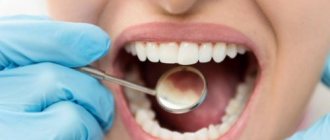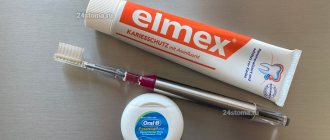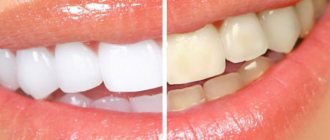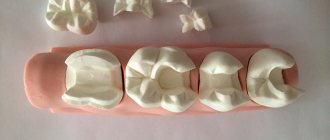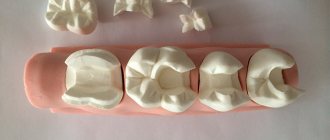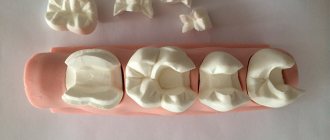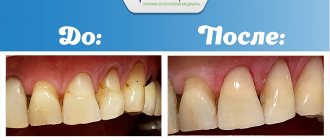Tooth enamel is one of the strongest tissues in the human body. However, the margin of safety given to us by nature is not always sufficient. Enamel is destroyed under the influence of external factors (cold and hot foods, whitening procedures), as well as from a lack of fluoride, calcium and phosphorus. One of the ways to restore it is to coat the teeth with fluoride varnish. Below we will tell you in what cases and how this procedure is carried out and what its effect on tooth enamel is.
Prices
| Deep fluoridation (one tooth) | 250 rub. |
Stages of caries
Everything related to this disease - symptoms, treatment methods, etc. – depends on the degree and stage of caries.
There are four stages of the disease:
- Spot. In this case, only the pigmentation of the enamel changes, that is, a dot or speck appears on its surface.
- Surface. At this stage, the doctor diagnoses damage to the shiny enamel layer of the tooth.
- Median. With this disease, pathogenic microbes eat away the hard tissues inside the crown of the tooth - dentin.
- Deep. This is the most dangerous type of caries, in which the degree of damage is so global that there is practically no partition left between the carious lesion and the chamber in which the pulp is located.
Indications for applying fluoride varnish
The range of indications for coating teeth with varnish is quite wide and includes many points. Therefore, almost everyone can use fluoride varnish. Most often, the procedure is performed in the following cases:
- with increased tooth sensitivity,
- for the prevention of caries,
- if there are areas of demineralization on the enamel,
- after ultrasonic teeth cleaning,
- before installing crowns,
- in case of injury.
This procedure has virtually no contraindications. These include only increased sensitivity to components and an excess of fluoride in the body. Teeth can be coated with fluoride varnish as early as 6 years of age. Allergic reactions to the composition of the varnish are extremely rare.
Symptoms of caries
- At the initial stage, caries manifests itself only externally. If the tooth is frontal, the patient himself may notice a black dot or a small dark spot. If the lesion begins to develop on the chewing teeth or on the lingual side of the row, only regular visits to the dentist will help to recognize the disease at an early stage.
- Median caries begins to make itself felt with discomfort while eating or drinking. An unpleasant, aching or painful reaction develops to sour, sweet, hot or cold.
- Patients who ignore going to the dentist and visit him extremely rarely may find a hole in the tooth cavity with their tongue. This means that caries has been eating away hard tissue for a long time and is already preparing to descend to the nerve.
Clinical researches
The effectiveness of ASEPTA series products has been repeatedly proven clinically. For example, multiple clinical studies have demonstrated that using ASEPTA propolis gum gel for a week can reduce gum inflammation by 31%. And the two-component mouth rinse ASEPTA ACTIVE more effectively combats the causes of inflammation and bleeding compared to single-component rinses - it reduces inflammation by 41% and reduces bleeding gums by 43%.
Sources:
- Comparative clinical evaluation of the effectiveness of treatment of traumatic lesions of the oral mucosa IORDANISHVILI A.K. *,** Doctor of Medical Sciences, Professor, Professor of the Department *Department of Orthopedic Dentistry of the Federal State Budgetary Educational Institution of Higher Education “North-Western State Medical University named after. I.I. Mechnikov" of the Ministry of Health of the Russian Federation (rector - Doctor of Medical Sciences Sayganov S.A.); **Department of Maxillofacial Surgery and Surgical Dentistry of the Federal State Budgetary Military Educational Institution of Higher Education “Military Medical Academy named after S.M. Kirov" of the Ministry of Defense of the Russian Federation (chief - Corresponding Member of the Russian Academy of Sciences, Professor A.Ya. Fisun).
- The role of anti-inflammatory rinse in the treatment of periodontal diseases (L.Yu. Orekhova, A.A. Leontyev, S.B. Ulitovsky) L.Yu. OREKHOVA, Doctor of Medical Sciences, Prof., Head of Department; A.A. LEONTIEV, dentist; S.B. ULITOVSKY, Doctor of Medical Sciences, Prof. Department of Therapeutic Dentistry of St. Petersburg State Medical University named after. acad. I. P. Pavlova
- Report on the determination/confirmation of the preventive properties of personal oral hygiene products “ASEPTA PLUS” Remineralization doctor-researcher A.A. Leontyev, head Department of Preventive Dentistry, Doctor of Medical Sciences, Professor S.B. Ulitovsky First St. Petersburg State Medical University named after. acad. I.P. Pavlova, Department of Preventive Dentistry
- Report on determining/confirming the preventive properties of toothpaste “ASEPTA PLUS” COFFEE and TOBACCO Author: doctor-researcher A.A. Leontyev, head Department of Preventive Dentistry, Doctor of Medical Sciences, Professor S.B. Ulitovsky. First St. Petersburg State Medical University named after. acad. I.P. Pavlova, Department of Preventive Dentistry
- Report on determining/confirming the preventive properties of toothpaste “ASEPTA PLUS” GENTLE WHITENING” Author: doctor-researcher A.A. Leontyev, head Department of Preventive Dentistry, Doctor of Medical Sciences, Professor S.B. Ulitovsky First St. Petersburg State Medical University named after. acad. I.P. Pavlova, Department of Preventive Dentistry
Causes of caries
- Bacterial
It is bacteria that can produce acids, destroying fluoride and calcium in the enamel and dentin. Already 2 hours after you brush your teeth, they begin to appear on the surface again, gather in colonies, form plaque, then tartar.
- Physiological
Some people produce little saliva. They are potential candidates for permanent dental problems. The more saliva in the mouth, the more the negative effects of bacteria are neutralized. Accordingly, if your mouth is dry, it is easier for caries to develop in it.
- Poor nutrition
Yes, sweets are bad for your teeth! Moreover, eating a huge piece of cake and then brushing your teeth is more beneficial for your teeth than eating one small candy at night and forgetting about hygiene. The fact is that the harmful effects of glucose on teeth depend not on the amount of sugar, but on how long the sweets are in contact with the tooth enamel in the mouth.
- Special conditions of the body
A pregnant woman can develop caries due to the fact that a certain part of the mineral substances from her skeletal system is spent on the development of the baby's fetus. The connection between stressful conditions and the development of caries has also been proven.
Indications and contraindications
Fluoride varnish coating is a preventive procedure that is suitable for adults and children. Dentists recommend it in the following cases:
- increased sensitivity,
- prevention of caries,
- exposure of the necks of the teeth,
- dental injuries,
- ultrasonic enamel cleaning,
- preparation for prosthetics,
- pregnancy,
- yellow enamel color.
Experts consider the following beneficial properties of fluoride varnish:
- Antibacterial effect - neutralizes bacteria. They lose the ability to process glucose. Thanks to this, acid is not released, which is dangerous for the enamel.
- Strengthening gums - the composition of fluoride varnish has a positive effect not only on enamel, but also on soft tissues. The product nourishes them.
- Restoring enamel - fluoride attracts calcium. The structure of teeth is improved at the molecular level.
- Reduced sensitivity - when the procedure is completed, fluoride varnish forms a strong and hard film on the enamel that is not visible. It reduces the sensitivity of enamel to various irritants: hot and cold, sour and sweet.
- Protection from external factors - extends the life of fillings, slows down the development of diseases.
There are also contraindications to coating teeth with fluoride:
- allergy to the components of the product,
- hypersensitivity to smells and tastes,
- epidemic fluorosis.
Treatment of caries
The principles and methods will vary depending on what stage of caries we are talking about. If this is a point or spot on the surface of the enamel, then the doctor will be able to do without preparation or drilling of hard tissue. Special compounds are used to apply to the stain, which saturate the affected area with minerals.
If mineralization is carried out efficiently and on time, the disease will recede and caries will not develop further. However, in most cases, patients come to the clinic when the stage of superficial caries is far behind. If enamel and dentin tissues are affected, the area softened by bacteria must be removed. For this purpose, modern drills are used, which, thanks to water-air support for drilling, ensure an almost completely painless procedure
The treatment algorithm for hard tissue preparation is as follows:
- Tooth isolation using a rubber dam
- Administration of anesthesia
- Preparation of tissue softened by bacteria
- Treatment of the exposed cavity with medicinal compounds
- Installing a seal
- Grinding and polishing of the filling to achieve an ideal external result
You can make an appointment with a therapist at the ILATAN clinic at any time. We treat teeth using modern and classical techniques, using high-tech equipment. In particular, the use of a microscope has proven itself to be excellent - cavity preparation occurs as accurately as possible, without the risk of removing excess healthy tissue. Call, sign up using the form on our website, come! We will ensure the health of your teeth!
How to clean teeth from caries
People don't like going to the dentist, that's a fact. Only this can explain such a widespread prevalence of caries. According to unofficial statistics, about 98% of the world's population suffers from this dental disease. And this despite the fact that with proper daily hygiene and professional cleaning of the oral cavity by a dentist at least once every six months, cariogenic bacteria would have no chance.
The proposed material discusses the basic principles of caries prevention and the algorithm for treating the disease depending on the stage of the pathological process. We will devote a little time to the reasons for the development of pathology, since this is necessary to understand the principles of organizing the preventive process.
Causes of caries
The first question we must ask ourselves is, what is tooth decay? This is a dental disease in which tooth enamel and dentin are destroyed. The order of development of the pathological process is exactly this: first, the carious defect develops in the enamel, and then moves to deeper dentin tissue. With a complicated disease, pathogenic bacteria penetrate even deeper into the soft tissues, and pulpitis develops.
The cause of caries is the development of pathogenic microflora, first on the surface of the enamel, and then in the dental tissues themselves. Bacteria that can cause the development of this disease are usually called cariogenic. This is a large group of microorganisms, many of which are opportunistic and constantly live in the oral cavity.
The cause of caries is the destruction of tooth enamel, and then dentin, by cariogenic microflora!
It is legitimate to talk about predisposing factors that contribute to the development of the disease. The first and most important is poor oral hygiene. Improper or irregular dental care creates the preconditions for the development of pathogenic bacteria. The more soft plaque or tartar on the teeth, the higher the risk of carious destruction.
Another group of predisposing factors is associated with certain conditions of the body. The main manifestation of the first stage of caries development is a decrease in mineralization (reduction in the amount of calcium) of tooth enamel with the formation of first a light and then a brown spot on its surface. Diseases of the endocrine system and other systemic diseases that are accompanied by impaired mineral metabolism contribute to the development of demineralization.
Demineralization can be accelerated by a lack of certain essential substances in the diet. We are not talking about calcium - there is just enough of it in foods. Much more often, doctors diagnose one degree or another of vitamin D deficiency. This vitamin is produced in the skin under the influence of ultraviolet radiation and plays a vital role in mineral metabolism. Vitamin D is low in foods, so if you rarely get exposure to the sun, you need to take it in the form of dietary supplements. It is also beneficial to take vitamin D (in the form of D-3) during the winter months.
Stages of the disease
The disease goes through several stages. Treatment of caries at home (assuming that this is possible, although this is not so) is allowed only at the white/brown spot stage. With superficial, and even more so, medium and deep damage to dental tissues, it is impossible to treat without the help of a specialist. This is a direct road to tooth loss and subsequent expensive dentures!
1. White/brown spot stage.
At this stage there is still no destruction of dental tissues; there is only pronounced demineralization of tooth enamel. The loss of calcium is manifested by the formation of a lightened area on the surface of the dental crown. It can be matte, bright or chalky, but the shade of the stain in any case is different from the color of healthy teeth. Severe pain is not typical for this phase; the patient may only be concerned about increased sensitivity when eating certain foods or cold/hot drinks.
As calcium salts are washed out of the dental tissues, the enamel becomes more and more porous, and food pigments begin to be deposited in it. As a result, the stain becomes brownish in color. This is still the initial stage of the disease, but the tooth is already on the verge of destruction.
2. Stage of superficial carious defect.
If the patient does not seek help at the white spot stage, a carious defect is formed - an area of destroyed enamel. Damaged dental tissue can only be restored using direct restoration, that is, filling. The defect will not heal on its own, and it is no longer possible to cure caries at home. Moreover, treatment with folk remedies can be harmful - a person will have the feeling that he is taking effective measures, although in reality the disease progresses and spreads to deep tissues.
3. Stage of average caries.
Unfortunately, carious destruction often spreads deep into the tooth, because people do not like to go to the dentist and prefer to use simple, albeit absolutely useless, folk remedies. We can talk about average caries when the carious cavity extends beyond the tooth enamel and affects the dentin.
Obviously, if it is impossible to cure the superficial form at home, then with carious damage to dentin, talking about self-treatment is even more pointless. There is no need to hope for a miracle and be treated with folk remedies, including rinsing with herbal tinctures and solutions. The algorithm of actions for the moderate form of the disease will be described in the next section of the article.
4. Stage of deep carious defect.
The development of a deep carious defect is indicated when a thin septum remains between the dentin and the pulp. In fact, the tissue of the crown is destroyed to its entire depth, and only a thin layer of still preserved dentin protects it from the penetration of cariogenic flora into the pulp.
5. Pulpitis
- complication. When cariogenic bacteria penetrate the pulp (soft tissue containing blood vessels and nerves), a complication of caries develops - pulpitis. A person feels severe toothache, which is practically not relieved by conventional analgesics. At this stage, since there is simply no other choice, many turn to a dentist for qualified help, although this should have been done much earlier. Pulpitis therapy is a much more complex, lengthy and expensive process. An uncomplicated form of the disease can be cured faster and cheaper.
How to treat caries
We start from the first stage, when the disease manifests itself in the form of a white or brown spot. How to cure caries at the initial stage of development of the pathological process? The main task is to restore enamel mineralization, that is, to compensate for calcium deficiency. In theory, you can try to do this at home. To do this, you need to brush your teeth with medicated toothpaste with a high content of calcium and fluoride, and also use special dental gels enriched with these compounds.
Unfortunately, self-medication at home does not always give the desired result. This is explained by the fact that even in the best toothpaste the concentration of active elements is lower than in professional products used by a dentist. In addition, an essential condition for success is cleansing the oral cavity from plaque and tartar, and this can only be done in a dental office equipped with an ultrasonic or Air Flow cleaning apparatus.
The correct algorithm looks like this. If an area of enamel lightening appears, you need to make an appointment with a dentist, undergo a teeth cleaning procedure and receive qualified assistance aimed at remineralizing the enamel. At the same time, you can brush your teeth with medicated toothpaste and rinse your mouth with various traditional medicines, for example, solutions of sage, chamomile or calendula.
Without cleaning teeth from plaque, caries treatment will be ineffective!
As an additional measure, it is recommended to take vitamin D, but only in its active form - D-3. It is sold at any pharmacy and is inexpensive. Taking the vitamin in a dosage of 400-800 IU per day will benefit everyone, not just patients with dental diseases.
Treatment of superficial caries
The only effective method is to remove the dental tissue affected by the pathological process, followed by filling the defect. Therefore, the question of how to get rid of caries at home is no longer relevant, unless you have a dental unit and a set of filling materials at home.
The good news is that dental care can be done in one visit to the dentist. The doctor will clean the teeth of plaque and stone, drill out a small area of enamel affected by caries, and place a filling made of photopolymer material. The cost of the procedure is low, since there is no need to depulpate the tooth and seal the root canals, as in the pulpitis stage.
Treatment of medium and deep forms
As in the case of a superficial carious defect, the basis of therapy is the removal of infected and destroyed tissues, followed by restoration of the crown using direct restoration (filling). The key differences relate to the method of preparing the tooth for filling.
With medium and deep lesions, the process spreads to the dentinal tissue. The distance between the carious cavity and the pulp is reduced, which increases the risk of developing pulpitis due to the penetration of microflora into the soft tissue. Therefore, in case of average caries, after drilling out all pathologically changed tissues, an insulating pad is placed on the bottom of the carious cavity. In case of deep damage, the dentist first places a therapeutic pad, and then an insulating one.
Before filling, the carious cavity is treated with powerful antiseptics. The purpose of this manipulation is to kill all microflora, which can lead to the development of relapse. Cariogenic bacteria are resistant to antibiotics in 99% of cases. To destroy them, strong topical agents are used.
After treatment with antiseptic solutions and isolation of the carious cavity from soft tissues, filling is performed. The doctor places a filling made of a light-curing polymer material, restoring the aesthetics and function of the diseased tooth.
If the tooth is more than half destroyed, direct restoration will not be effective enough. The patient may be recommended to reconstruct the coronal part of the tooth with a restorative inlay or through dentures - installing an artificial crown made of ceramic, zirconium or metal ceramics on the tooth stump.
These orthopedic treatment options require preliminary depulpation of the tooth, which significantly increases its final cost. You also need to add the cost of artificial crowns to the price. It is obvious that treating caries in the early stages not only allows you to preserve a living tooth, but also significantly reduces the cost of dental care.
Treatment of pulpitis
It is much more difficult to cure caries complicated by pulpitis. Typically, two, three or even four visits to the dental clinic are required. At the first visit, the doctor drills out the affected dental tissues, removes blood vessels and nerves from the root canals, treats the canals with an antiseptic solution and places a temporary filling.
At the second visit, the temporary filling is removed, the canals are re-treated with an antiseptic and sealed with dental sealant. Sealing the canals is a key condition for successful treatment of pulpitis. If voids remain in the canal, the risk of infection, post-filling pain and relapse increases.
On the third visit, after the dental sealant has completely hardened, a direct restoration of the coronal part of the tooth is performed with a light-curing polymer. Some dentists place a filling on the second visit, but this is the wrong strategy, chosen to save time. It is better to install the seal after the sealant has completely hardened, which takes several days.
conclusions
Treatment of caries should be left to professionals. You should contact the dental clinic at the white spot stage - this will preserve living tissue in full, speed up treatment and reduce its cost. Various self-help options with folk remedies are suitable only as additional measures, as well as the use of medicated toothpaste.
Effective prevention of caries consists of proper daily cleaning of teeth from plaque and food particles using high-quality toothpaste, floss and, if possible, an irrigator. It is also necessary to sanitize the oral cavity at the dentist once every six months. The procedure is combined with a preventive examination, which is very important for the timely and earliest possible diagnosis of dental diseases.
If you still have questions about caries treatment methods, ask them to a qualified medical dentist during your consultation.
Treatment of caries in adults at various stages:
- superficial. The initial stage of this disease is characterized by a small zone of carious cavity and small areas of demineralization. In such cases, medicinal preparations based on phosphorus, calcium and fluorine are used. They are applied to the tooth surface for additional protection. The infected cavity is sealed after treatment;
- average. In this case, local damage to dental tissues already occurs. They may also experience periodic pain. In such situations, the affected tissues are cleaned and subsequently filled. If necessary, local anesthesia is used;
- deep. At this stage, extensive damage to the dental tissue occurs, sometimes the nerve is affected (acute pain, festering areas, swelling of the gums occur). Treatment of caries in such cases is more thorough and longer. It consists of therapeutic procedures in the dental canals, cleansing the diseased cavity, filling and subsequent restoration of the tooth shape.
Fluoridation: strengthening and protecting teeth
Since childhood, we have all been told that we need to eat less sweets and more fresh fruits, vegetables and dairy products. And why all? They contain useful vitamins and minerals that support the health of the body, give energy and strength. Our teeth also need additional nutrition. When teeth are strong from the inside, they are better able to withstand external influences, which means that the risk of caries is reduced significantly. How to strengthen and restore tooth enamel? What is fluoridation and why is fluoride varnish needed?
Fluoridation of teeth for children: benefit or harm?
The child’s baby teeth are not yet strong: they have fragile enamel, followed by a thin dentin layer, and at the base there is a soft pulp chamber with nerve endings and blood vessels. Therefore, children's teeth are more easily damaged; caries often forms on them, which can quickly develop into complications. It seems like just yesterday there was a small dark spot on the enamel, and today your child is complaining of severe toothache and refuses to eat.
To reduce the risk of tooth decay, baby teeth need to be cleaned regularly and properly, and strengthened. How can you help your children maintain a beautiful smile and protect them from toothache? With the appearance of the first teeth, bring your child to the dentist for a preventive examination 2-3 times a year. The pediatric dentist will promptly identify possible problems, teach in a playful manner the correct technique for brushing teeth, and also carry out fluoridation that is beneficial for the enamel.
Simple fluoridation of teeth
The most common way to strengthen teeth. It is used to prevent caries. A special composition is applied to the enamel, which forms a thin protective film. What kind of composition is this? Fluoride varnish, fluorine-containing varnish, fluoride varnish or simply enamel restoration varnish - the strengthening agent has several names, but the result is the same. Your teeth are reliably protected, and the effect lasts up to six months.
